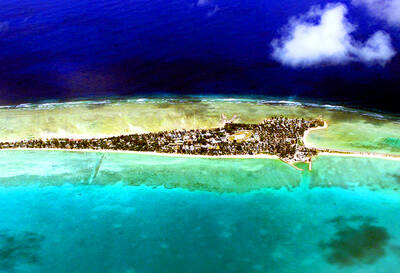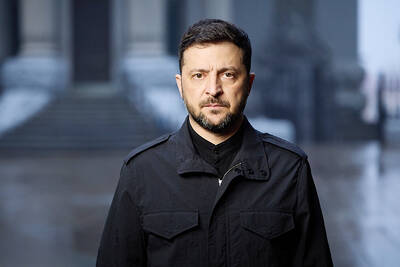Six aftershocks jolted a remote southern Indian archipelago where villagers were fighting yesterday to survive without water or food after Asia's devastating tsunami, officials said.
The 5.2-5.9 magnitude tremors on Friday night and early yesterday came as authorities tried to reach the survivors who are desperate for humanitarian aid. There were no reports of casualties from the new quakes.
India has so far denied international aid groups access to enter most of the island territory of Andaman and Nicobar, the last tsunami blind spot where casualties are not known but feared to be in the thousands.
"There is nothing to eat there. There is no water. In a couple of days, people will start dying of hunger," Anup Ghatak, a utilities contractor from Campbell Bay island, said as he was being evacuated to Port Blair, the capital of the territory.
Yesterday, India raised its official death toll to 8,942 -- a jump of more than 1,100. Most of the deaths, 7,397, have occurred in the southern state of Tamil Nadu. However, that does not include a complete count in the island territories. An island official said Friday that 712 bodies had been buried or cremated there, and at least 3,754 people were missing amid the debris of crumbled homes, downed trees and mounds of dead animals on several islands.
That lowered a government estimate Thursday of 10,000 missing in the hundreds of islands scattered over some 7,000km in the Bay of Bengal. The Red Cross said earlier up to 30,000 could be missing.
Homeless and stunned victims of last Sunday's disaster poured into eight relief camps in Port Blair with harrowing tales of death and destruction. Walking long distances through dense forests to get to the nearest airfield, they were grateful they had survived but eager to learn if their friends and families were safe.
"There is starvation. People haven't had food or water for at least five days. There are carcasses. There will be an epidemic," Manoranjan Bhakta, Andaman's lawmaker to the federal parliament, told reporters after being surrounded on a roadside by people demanding food and water for stranded family members.
Indian authorities have traditionally barred foreigners from most of the islands -- partly for security reasons because of an Indian air force base in Car Nicobar and also to protect a dwindling group of indigenous people. Even Indians need special permits to travel there.
Some 40 percent of the densely forested area is designated as a tribal reserve where indigenous people live; the remaining area is protected for wood cultivation.
A few international relief agencies have begun working in Port Blair -- the territory's capital, where permission is not needed to enter -- but are unable to go deeper into the archipelago's 500 islands.
The missing in Andaman and Nicobar Islands could not be presumed dead because they could have survived in coconut groves that dot the islands, said V.V. Bhat, chief secretary of the islands.
"It's possible that a good number of them might have survived in coconut gardens. Coconuts would have provided sustenance, but we can't hazard a guess," Bhat told reporters. Drinking water shortages have been reported, but local people were making do with eating coconut kernel and drinking coconut water, officials said.
"In the southern parts, people have suffered a lot. There is water scarcity everywhere. We fear an epidemic," said Tarak Banerjee, director of the disaster preparedness unit at the Voluntary Health Association of India.
Many villagers alleged relief was reaching the islands but was hoarded by local officials.
Relief operations on the remote archipelago -- which starts approximately 500km northwest of the quake's epicenter -- have been limited to Indian officials and local volunteers who have struggled to deliver tonnes of rations, clothes, bed sheets, oil, and other items, hampered by lack of transportation to the remote islands.
"We would like to be invited to join the relief effort, and to be part of any helicopter or boat trip to the area," an official with the Paris-based Medecins Sans Frontieres (Doctors Without Borders) said at a news conference.
International humanitarian group Oxfam also requested entry. But Lieutenant Governor Ram Kapse, administrator of the federally governed territory, said no decision had been made. He said four Indian volunteer groups have been allowed to travel to the islands.
Sharath Babu, head of a group of amateur HAM radio operators, said his colleagues in the worst parts of Car Nicobar island reported "relief is not reaching the people. People are hungry."

DISASTER: The Bangladesh Meteorological Department recorded a magnitude 5.7 and tremors reached as far as Kolkata, India, more than 300km away from the epicenter A powerful earthquake struck Bangladesh yesterday outside the crowded capital, Dhaka, killing at least five people and injuring about a hundred, the government said. The magnitude 5.5 quake struck at 10:38am near Narsingdi, Bangladesh, about 33km from Dhaka, the US Geological Survey (USGS) said. The earthquake sparked fear and chaos with many in the Muslim-majority nation of 170 million people at home on their day off. AFP reporters in Dhaka said they saw people weeping in the streets while others appeared shocked. Bangladesh Interim Leader Muhammad Yunus expressed his “deep shock and sorrow over the news of casualties in various districts.” At least five people,

It is one of the world’s most famous unsolved codes whose answer could sell for a fortune — but two US friends say they have already found the secret hidden by Kryptos. The S-shaped copper sculpture has baffled cryptography enthusiasts since its 1990 installation on the grounds of the CIA headquarters in Virginia, with three of its four messages deciphered so far. Yet K4, the final passage, has kept codebreakers scratching their heads. Sculptor Jim Sanborn, 80, has been so overwhelmed by guesses that he started charging US$50 for each response. Sanborn in August announced he would auction the 97-character solution to K4

SHOW OF FORCE: The US has held nine multilateral drills near Guam in the past four months, which Australia said was important to deter coercion in the region Five Chinese research vessels, including ships used for space and missile tracking and underwater mapping, were active in the northwest Pacific last month, as the US stepped up military exercises, data compiled by a Guam-based group shows. Rapid militarization in the northern Pacific gets insufficient attention, the Pacific Center for Island Security said, adding that it makes island populations a potential target in any great-power conflict. “If you look at the number of US and bilateral and multilateral exercises, there is a lot of activity,” Leland Bettis, the director of the group that seeks to flag regional security risks, said in an

‘DIGNITY’: The Ukrainian president said that ‘we did not not betray Ukraine then, we will not do so now,’ amid US pressure to give significant concessions to Russia Ukrainian President Volodymyr Zelenskiy on Friday pushed back against a US plan to end the war in Ukraine, while Russian President Vladimir Putin welcomed the proposal that includes many of his hardline demands. With US President Donald Trump giving Ukraine less than a week to sign, Zelenskiy pledged to work to ensure any deal would not “betray” Ukraine’s interests, while acknowledging he risked losing Washington as an ally. Putin said the blueprint could “lay the foundation” for a final peace settlement, but threatened more land seizures if Ukraine walked away from negotiations. Ukraine faces one of the most challenging moments in its history,